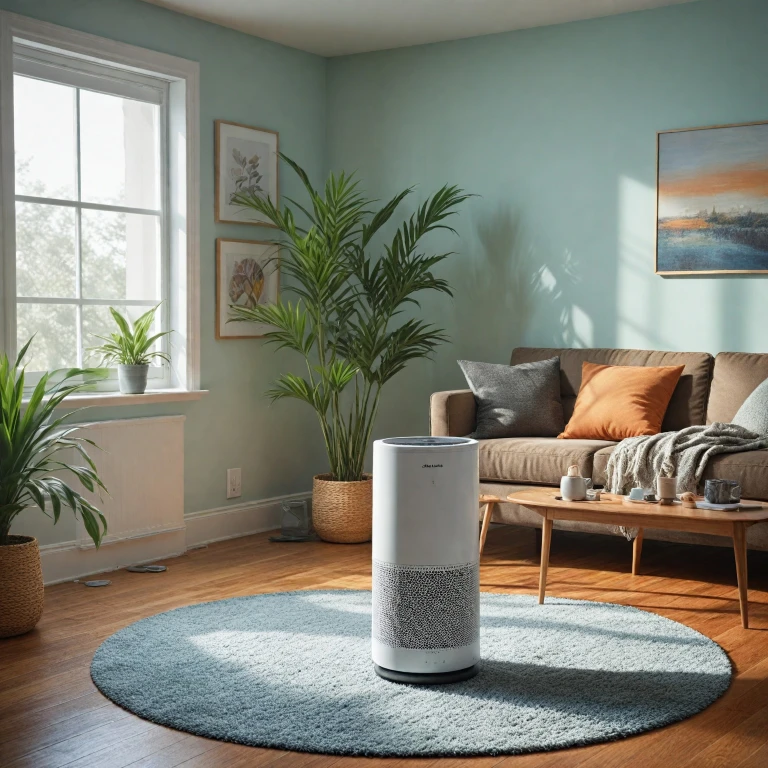Understanding how air purifiers work
Functionality at a Glance
Air purifiers function by circulating a room's air through various types of filters tailored to capture specific pollutants. These units often incorporate a fan to draw in ambient air, which then passes through different filtration stages to remove airborne particles, including odors. A commonly used feature in air purifiers is the inclusion of high-efficiency particulate air (HEPA) filters. These are particularly adept at trapping minute particles, such as pet dander and smoke particles, enhancing the overall air quality within a room.
Significance of Filters
The effectiveness of an air purifier in alleviating indoor odors greatly depends on the type of filters it employs. HEPA filters are highly efficient at capturing smaller particulate matter, but when it comes to odors, activated carbon filters play a crucial role. These filters are engineered to adsorb gases and odors, thus providing a mechanism to tackle persistent smells.
For enduring odor problems, selecting a unit equipped with carbon filters is crucial. Such filters can be particularly effective with unpleasant smells related to smoke, cooking, and even pet odors. If you’re exploring the benefits of such filters,
understanding the benefits of charcoal filters in air purifiers is instrumental.
Long-Term Considerations
A critical aspect to evaluate in any air-purifying system is the need for regular filter replacement. Over time, the effectiveness of filters diminishes, and stale odors may resurface if replacement is neglected. It becomes important to check not only the lifespan of the filters but also the cost and availability, ensuring that the air in your space remains clean and fresh.
Thus, understanding these core components provides the baseline for evaluating a purifier's capability with odors, guiding you towards making an informed decision on the right device for your needs.
Types of air purifiers and their effectiveness on odors
Exploring Various Air Purifier Technologies and Their Impact on Odors
When considering the effectiveness of air purifiers in combating odors, understanding the different technologies is crucial. Here's a breakdown of the most common types and their impact on odors and overall air quality:
- HEPA Filters: High-Efficiency Particulate Air (HEPA) filters are renowned for trapping airborne particles such as dust, pet dander, and pollen. While they excel at removing particulate matter, HEPA filters alone aren't specifically designed for odor reduction. Pairing HEPA filters with other technologies can enhance their effectiveness across a broader range of indoor air issues.
- Activated Carbon Filters: These filters are particularly effective against odors and volatile organic compounds (VOCs). Through a process known as adsorption, activated carbon binds to gases and odors, neutralizing unpleasant smells. This technology is ideal for removing smoke, cooking odors, and other gaseous pollutants. To learn more about how activated carbon can benefit your air purifier experience, check this charcoal filter guide.
- Bipolar Ionization: A more modern technology, bipolar ionization releases charged particles that can neutralize odors by disrupting their molecular structures. While this method is effective, it's advised to check the quality and safety of the units, as some models may produce ozone.
Understanding these technologies will guide you in choosing the right air purifier unit for your needs, enhancing your experience in combatting household odors. Each method has its strengths, so considering the specific odor sources in your home environment is crucial when making a selection.
Common sources of indoor odors
Identifying the Usual Culprits Behind Indoor Odors
Indoor environments can be plagued by a myriad of odors emanating from various sources. Although some odors are benign, others can significantly affect the quality of life and may even indicate underlying air quality issues. Recognizing these common sources of indoor smells is crucial to effectively tackle them with the right air purifier.
- Cooking Odors: The kitchen is a hotspot for lingering smells. Grease, food particles, and smoke from cooking often hang in the air long after meals are prepared. These odors can be particularly stubborn, especially in closed environments where they tend to "fill" the room.
- Pets: While we love our furry friends, pet dander, and associated smells from pet accidents or general animal odors can contribute significantly to an indoor odor issue. Using a purifier with high-efficiency particulate air (HEPA) filters can help with capturing dander.
- Tobacco Smoke: Smoking indoors can lead to deeply embedded odors that are difficult to remove. Smoke particles and tar not only affect the air but also stick to surfaces, exacerbating the smell.
- Mold and Mildew: Odors of dampness or mustiness often point to mold or mildew problems. These smells indicate not only a nuisance but a potential health risk due to the presence of mold spores or mycotoxins in the air.
- Household Chemicals: Cleaning products, paints, and other chemicals can release volatile organic compounds (VOCs) that contribute to poor indoor air quality and lead to persistent chemical odors.
Understanding these common sources of indoor odors is an essential first step towards managing them effectively. Employing a unit with an activated carbon filter is often recommended for absorbing odors and improving indoor air quality. For more comprehensive information on how certain types of purifiers tackle specific odors, you might want to explore
the benefits of a Guardian air purifier.
Factors influencing odor removal
Factors Impacting Odor Removal Efficiency
The effectiveness of air purifiers in tackling indoor odors depends on several critical factors. Understanding these can aid in optimizing your choice and use of a purifier for your specific needs.
Room Size and Air Circulation
The size of the room greatly influences the performance of an air purifier. Smaller units may struggle in larger spaces, as the purifier's fan needs to accurately circulate the air to capture odors effectively. It's crucial to select a unit with a capacity suitable for your room's dimensions to ensure optimal air quality.
Filter Types and Their Condition
The type of filters used in the air purifier can significantly impact odor removal. HEPA filters excel at capturing particulate matter and are ideal when paired with carbon filters, which specialize in absorbing various odors. Regular filter replacement is also vital to maintain efficiency, as clogged filters can hinder performance.
Source and Intensity of Odors
The origin of odors also plays a role. For example, consistently dealing with strong smells such as smoke or pet dander requires purifiers specifically designed for these purposes. Consider models equipped with a true HEPA filter for smoke and activated carbon for organic odors to effectively mitigate strong scents.
Additional Technology
Some purifiers incorporate extra technology like bipolar ionization, which can boost odor removal. These units generate ions that interact with airborne particles, breaking down odors and enhancing the unit’s overall effectiveness.
Taking into consideration these factors can greatly enhance your ability to control odors, providing consistently clean air. Tailoring your choice of air purifier in response to these aspects is key to achieving the best air quality results in your home.
Real-life experiences and testimonials
Sharing Real-life Experiences with Air Purifiers
Exploring real-life experiences and testimonials can be incredibly informative for anyone considering an air purifier for odor control. Many individuals have shared their experiences with different units and their ability to effectively reduce, if not completely eliminate, unwanted smells.
- Testimonial 1: Tackling Pet Odors
One common issue in households with pets is the persistent odor of pet dander and other animal-related smells. Users with pets have found that air purifiers equipped with true HEPA filters and activated carbon can substantially reduce these odors. The combination of HEPA filters capturing airborne particles and carbon filters absorbing smells has proven effective in maintaining clean air.
- Testimonial 2: Cooking Smells
Cooking, particularly frying or preparing strong-smelling foods, can leave lingering scents in the kitchen and surrounding rooms. Reports indicate that with purifiers featuring a substantial carbon filter, these cooking smells can be reduced significantly, leaving the room smelling fresher. Users often note that larger units can help with more spacious kitchen areas.
- Testimonial 3: Smoking Indoors
Smoke, whether from cigarettes or other sources, is a challenging odor to manage indoors. Feedback from users who smoke inside suggests that air purifier units with high-quality filtration systems, including HEPA and carbon filters, are capable of reducing the persistent smoke smell. For better performance, individuals often recommend units with strong fan capabilities to circulate and clean large quantities of air quickly.
- Long-Term Use and Maintenance
Continuous use of an air purifier can ensure ongoing odor control. Many users point out that regular filter replacement, especially for carbon filters, is crucial to maintain the unit’s effectiveness. Ignoring filter replacement can diminish an air purifier's capacity to handle odors over the long term, underscoring the importance of maintenance.
These real-life experiences underline the value of investing in a good quality air purifier. While individual results can vary, ensuring that the unit is equipped with both efficient HEPA and activated carbon filtration systems and is suitably matched to the room's size can enhance odor removal effectiveness.
Tips for choosing the right air purifier for odor control
Strategies for Selecting the Ideal Air Purifier
When it comes to finding the perfect air purifier for combating odors, there are several points to consider to ensure optimal air quality in your indoor environment. Here are some tips to guide you in choosing the right unit:
- Understand Your Needs: Determine the primary source of odors in your space, such as smoke, pet dander, or food smells. This will help you identify if you need specialized filters, like HEPA filters for particulate matter or activated carbon filters for odor control.
- Room Size Consideration: Ensure the air purifier is suitable for the size of the room it will be used in. Larger rooms require units with a higher Clean Air Delivery Rate (CADR) to effectively remove odors and airborne particles.
- Filter Types and Maintenance: Evaluate the types of filters the purifier uses. Units with a combination of carbon and HEPA filters are often more effective in addressing both odors and indoor air pollutants. Regular filter replacement is essential to maintain efficiency, so check the cost and availability of replacement filters.
- Look for Advanced Features: Some air purifiers feature technologies like bipolar ionization to further enhance odor control. These additional features can contribute to long-term air quality improvements.
- Monitor Air Quality: Choose a unit with an air quality monitor to track improvements over time. This can be particularly helpful with identifying persistent odor issues.
- Noise Levels: Consider the noise level of the air purifier, especially if it will be placed in a living room or bedroom. Opt for a unit with adjustable fan speeds to balance between performance and quiet operation.
By taking these factors into account, you can select an air purifier that not only meets your needs in terms of odor control but also maintains a healthier indoor environment overall.

